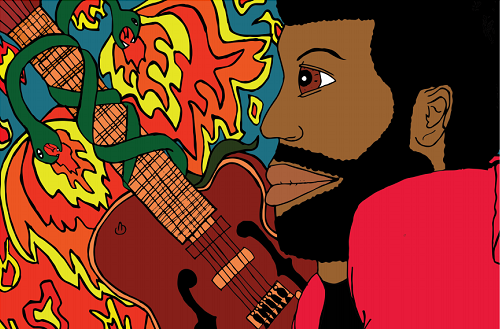Thundercat: Collaborator, Virtuoso Bassist, Musical Genius
For more than a decade, Stephen Bruner has played with a wide range of bands and artists, including local jazz ensembles, the L.A. punk band Suicidal Tendencies, Snoop Dogg, and Erykah Badu. This experience has led him to becoming a well-known bass player in the underground L.A. scene.
In 2011, Bruner’s experience playing metal, R&B, hip-hop, and jazz inspired him to combine these genres together and go solo. Instead playing the lead guitar as a frontman, he keeps his bass in order to create a spaced-out jazz / hip-hop fusion. Thundercat explains to Billboard Magazine, “In a way it probably is more prominent because I’m not playing like a traditional jazz bassist with a walking bass line or holding one note. I’m doing different chord progressions and rhythmic things like on a piano.”
Music lovers wonder, “What on earth is his songwriting process?” He confessed to the L.A. publication Losbangelos that the best way to create original music is to collaborate with other musicians because they can put a different spin on things.
D.J. / producer / instrumentalist Steven Ellison, a.k.a. Flying Lotus helped produce all of Thundercat’s music throughout his entire solo career. Thundercat explains that there were times during recording when he felt like they were speaking telepathically, complementing each other’s unique creative process.
Flying Lotus co-produced Thundercat’s first solo album, The Golden Age of the Apocalypse (2011). According to “Willamette Week,” the album lends “his cinematic eye to a record blending ’70s jazz fusion, stargazing soul, and ambient electronica into a head-tripping cosmic swirl.” The tracks on this album show Thundercat’s emergence and search for his own sound as he experiments with nostalgic and futuristic genres and sounds.
In 2013, Thundercat incorporated more vocals and heartbreak on his second album Apocalypse. This album was recorded right after the death of Bruner’s close friend and music partner, keyboardist Austin Peralta. At 22 years of age, Peralta died of pneumonia, which inspired Thundercat to dedicate most of this album to his friend. Thundercat tells Billboard Magazine, “We were around each other almost every day and the guy just disappeared into a whole other realm where I can’t see him anymore. He could be one of the X-Men right now for all I know. I don’t know. I was just trying to find some way to show how that really feels.”
Based on Thundercat’s two albums, The Golden Age of the Apocalypse and Apocalypse, you may be thinking, what’s his fixation on the end of the world? He answered, “It’s like, ‘You’ve heard The Golden Age of the Apocalypse, now comes Apocalypse! Next up, ‘After the Apocalypse!’ So it’s a joke, but I do also take it seriously. It sort of represents the end of an era for me. Not quite adolescence, but a changing of the guard. A lot of things happened in the time frame of making this album in my personal life. From one of my closest friends dying to the emotional changes you witness in relationships.”
He adds, “It also represents that I was at one point younger and in a learning phase, but now I’m Thundercat—I can’t deny it anymore.”
This year, Thundercat’s EP The Beyond / Where the Giants Roam gets in touch with sounds of the outdoors. While songs like “Song for the Dead” and “Them Changes” evoke a Michael Jackson influence with their uplifting melody and soft-jazz sound, “Lone Wolf and Cub” and “That Moment” embrace the sounds of folk-soul and combine experimental acoustic guitar and electronica.
Thundercat collaborates with artists who share his love of experimentation. He contributed to Kendrick Lamar’s anticipated album, To Pimp a Butterfly. He will also be collaborating with rappers like Mac Miller, Wiz Khalifa, Lil B, Earl Sweatshirt, singersongwriter Erykah Badu, and Stanley Clarke from the soul group The Internet.
What’s next for Thundercat? According to Billboard Magazine, he is working on producing another album with Lotus

.





